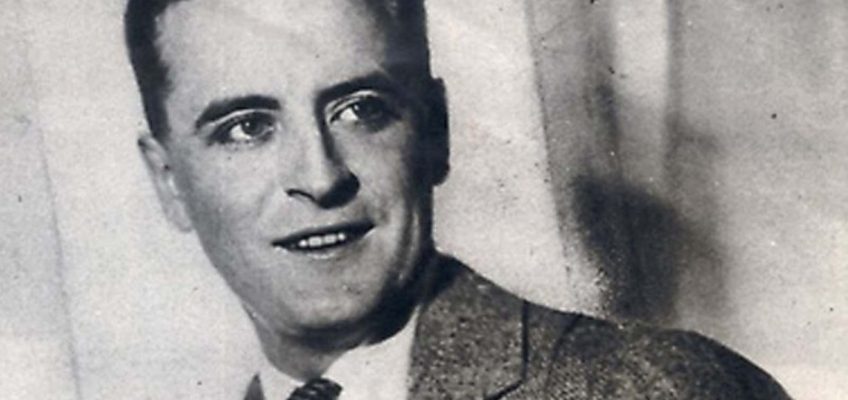F. Scott Fitzgerald fans across the globe are celebrating the centennial of “The Great Gatsby” this year.
From Princeton University, Fitzgerald’s alma mater, to the French Riviera, where he worked on the novel, this milestone anniversary will be marked with all kinds of “Gatsby”-themed events.
Here in the author’s birthplace, St. Paul will host parties, exhibits, performances and more — even a live reading of the entire novel at the Minnesota History Center on Thursday.
F. Scott Fitzgerald in the third-floor bedroom of his parents’ residence at 599 Summit Ave., where he wrote “This Side of Paradise.” (From the “Sight Unseen” exhibit at the George Latimer Library in downtown St. Paul)
But all this fuss over “Gatsby” would have been hard to imagine when it first landed on store shelves 100 years ago. After receiving mixed reviews from literary critics, the book sold poorly.
Fitzgerald died in 1940 believing it was a flop, said Maureen Corrigan, book critic for NPR’s Fresh Air program and author of “So We Read On: How ‘The Great Gatsby’ Came to Be and Why it Endures.”
“He really did think it was a failure,” Corrigan said. “The torture was he knew he had written a great book, and he wanted people to read it. … I do think it broke his heart that it wasn’t received as anything special by a lot of people.”
In St. Paul, Fitzgerald’s hometown newspapers did little to help, offering only qualified praise of his masterpiece in their 1925 reviews.
It was “the best of his novels,” but “not of the greatest importance.” It was “never dull for a moment,” but full of “stupid” characters and “very little” plot.
The book’s lukewarm reception in the local press may not be surprising given its author’s complicated relationship with St. Paul, said Mark Taylor, a Fitzgerald historian who gives walking tours of his old haunts along Summit Avenue.
“It seems like there was a reluctance on the part of St. Paul to embrace Fitzgerald during his lifetime … perhaps wanting to distance the city from this person who is known for having led kind of a fast life,” Taylor said.
‘They raised eyebrows’
Fitzgerald had made a triumphant return to the city that shaped him four years before “Gatsby” was published.
Already the acclaimed author of “This Side of Paradise,” he was working on revisions to “The Beautiful and Damned” in summer 1921 when he moved back to his hometown with his pregnant wife, Zelda.
F. Scott and Zelda Fitzgerald at Dellwood on White Bear Lake the month before their daughter, Scottie, was born. (Courtesy of the Minnesota Historical Society)
The Fitzgeralds were by then national celebrities and avatars of the Roaring Twenties, famous for their glamorous, gin-soaked lifestyle in New York.
“Fitzgerald was one of the first people who was famous for being famous,” said Dave Page, a St. Paul historian, of the author’s life and career. “He and Zelda understood that they could monetize their fame.”
They became known in St. Paul for wild parties that earned them a handful of eviction notices from a series of fashionable lodgings — and perhaps the disapproval of their neighbors.
“They raised eyebrows, that’s for sure,” Page said. “St. Paul was a very conservative, Catholic town. You just didn’t do that kind of stuff. You didn’t make a big deal out of yourself. It was very Victorian, and the Fitzgeralds were post-Victorian.”
Thomas Boyd, a friend of Fitzgerald’s who was then the literary editor of the St. Paul Daily News, wrote in March 1922 that the author appeared to have “ruffled the composure of his fellow townsmen.”
After the successful release of “The Beautiful and the Damned,” Fitzgerald began to workshop the story that would become “Gatsby” that summer at a rented house in White Bear Lake, but he wouldn’t write it here.
He and Zelda had both had enough of Minnesota, and they moved back to New York with their infant daughter, Scottie, that fall. They would never return to St. Paul.
Fitzgerald carefully crafted “Gatsby” over the next couple of years, infusing his Jazz Age melodrama with artful commentary on class, wealth, ambition and the American dream.
“Fitzgerald thought ‘Gatsby’ was going to be the novel that would break all the records,” Corrigan said. “It was going to top ‘This Side of Paradise.’ It was going to raise his literary reputation even higher. … And it didn’t.”
Not-so-great ‘Gatsby?’
Critics greeted “Gatsby” with ambivalence when it was released on April 10, 1925. Many reviews praised Fitzgerald’s elegant prose but dismissed the book’s literary significance.
The first mention to appear in the St. Paul papers was an unsigned review in the Pioneer Press on April 19, which called it by “far the best of his novels.” Its praise, however, was a bit backhanded.
The dust jacket of “The Great Gatsby.” (Courtesy image)
“While the work itself is not of the greatest importance, it does mark a distinct advance in the author’s command of his medium,” the anonymous critic wrote.
The St. Paul Daily News was even less generous in its review on May 3, despite admitting that “Gatsby” was “never dull for a moment.”
“Of plot there is very little, save for some hectic love affairs that are not above reproach, the author’s aim and interest all being centered on Gatsby himself,” wrote Clifford Trembley, the paper’s books editor. “Personally I don’t think the fellow was worth so much effort.”
That same day, the Pioneer Press returned to “Gatsby,” publishing a Chicago Tribune review by H.L. Mencken that — despite praising the “charm and beauty” of Fitzgerald’s writing — called the book itself “no more than a glorified anecdote” and “obviously unimportant.”
Fitzgerald was wounded by the critical indifference to his novel — and by its lackluster sales. While Fitzgerald’s first two novels had each sold about 50,000 copies, “Gatsby” managed a meager 21,000.
When he died in 1940, Fitzgerald and his work were largely forgotten, evidenced by the many unsold copies of “Gatsby” gathering dust in his publisher’s warehouse, Corrigan said.
Fitzgerald was eulogized in the St. Paul Dispatch by his friend James Gray, the newspaper’s literary and drama critic, who seemed to sense the book’s significance.
“He wrote one novel, ‘The Great Gatsby,’ which reveals his gift at its most urbane, sensitive and imaginative,” Gray wrote. “It is one of those small masterpieces which inevitably misses tremendous popular success because its implications are more subtle than the casual public cares to disentangle from a melodramatic story.”
“Perhaps some day it will be rediscovered,” he hoped. He didn’t have to wait long.
New life for an ‘old sport’
The United States entered World War II almost exactly a year after Fitzgerald’s death — and it would help revive his masterpiece.
A consortium of booksellers and publishers decided American troops overseas would benefit from some free reading material they could carry with them into battle. Their answer was the Armed Services Editions — hundreds of titles printed on cheap paper and handed out to GIs, who devoured them in their downtime.
Melting snow beads off a statue of F. Scott Fitzgerald in St. Paul’s Rice park on Nov. 6, 2013. The statue was unveiled in 1996 as part of a celebration of the author’s 100th birthday. (John Doman / Pioneer Press)
Roughly 155,000 copies of “The Great Gatsby” found their way into the hands of American servicemen through the ASE series — several times more than had been sold during Fitzgerald’s lifetime.
The book’s popularity surged in post-war America, and a 1951 biography of its author by Arthur Mizener helped bring Fitzgerald and his work back into the public consciousness.
Fans of the late St. Paulite began making pilgrimages to his hometown. Ethel Cline, who lived in the Summit Avenue row house where Fitzgerald finished writing “This Side of Paradise,” told the Pioneer Press in 1958 that “she has received numerous callers curious about Fitzgerald’s days in St. Paul.”
Over the years, the city has fully embraced its association with the famous author, and “Gatsby” — his “glorified anecdote” — has become one of the most acclaimed novels of all time.
“It’s our greatest ‘great American novel’ about class and the hidden ways in which that American promise doesn’t extend equally to everyone,” Corrigan said. “Gatsby tells us the American dream is a mirage, but at the same time, we reach for it. Fitzgerald said the novel is about aspiration. And he thinks aspiration is beautiful.”
Related Articles
2,350 Minnesotans were sterilized under state’s 1925 eugenics law — most of them women
One of the FBI’s original 10 Most Wanted Fugitives was caught in St. Paul — by a bunch of kids
Sign up for From the Archives, our weekly St. Paul history newsletter
How the COVID-19 pandemic shut down Minnesota in three weeks
Photo gallery: Throwback Thursday




